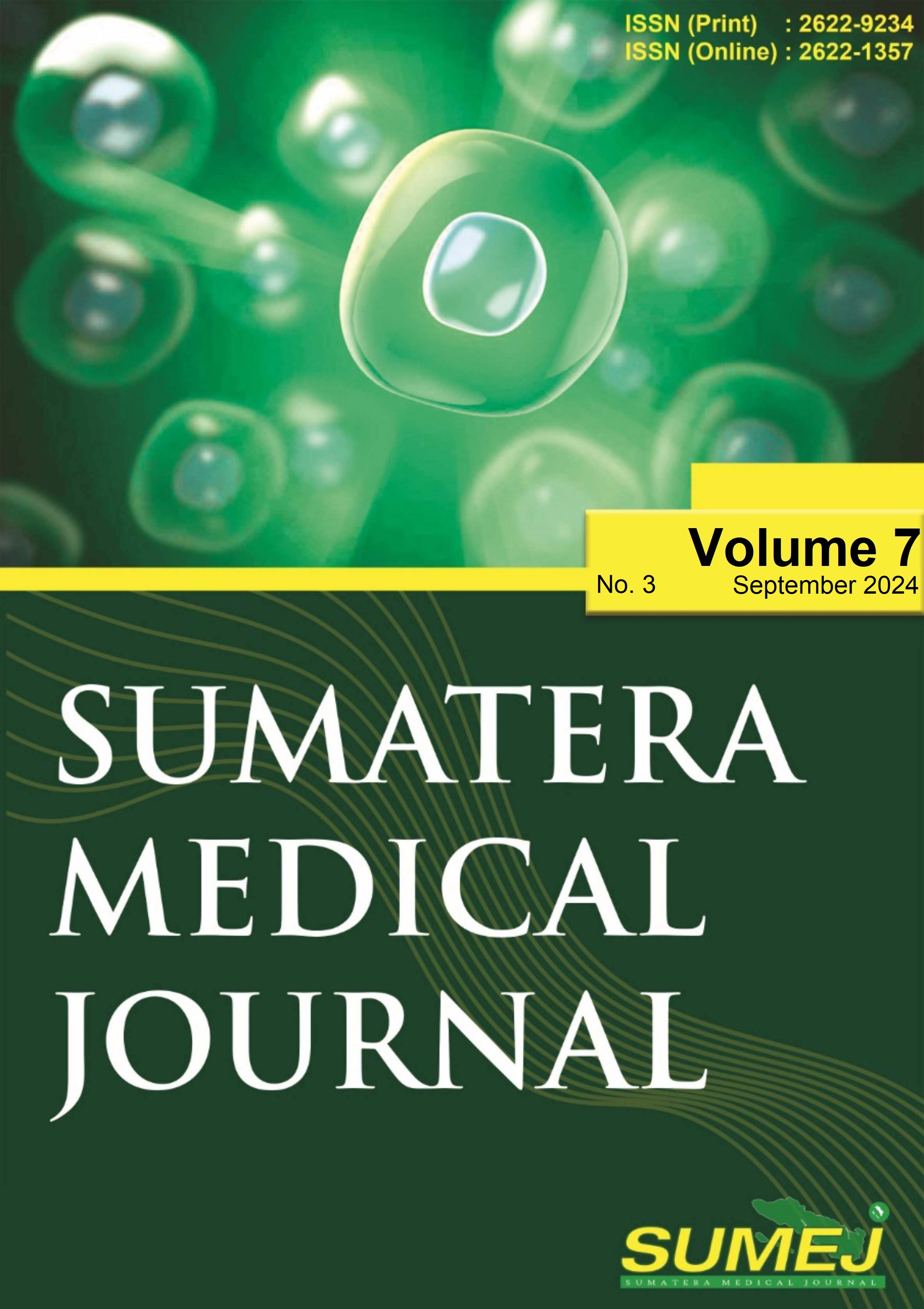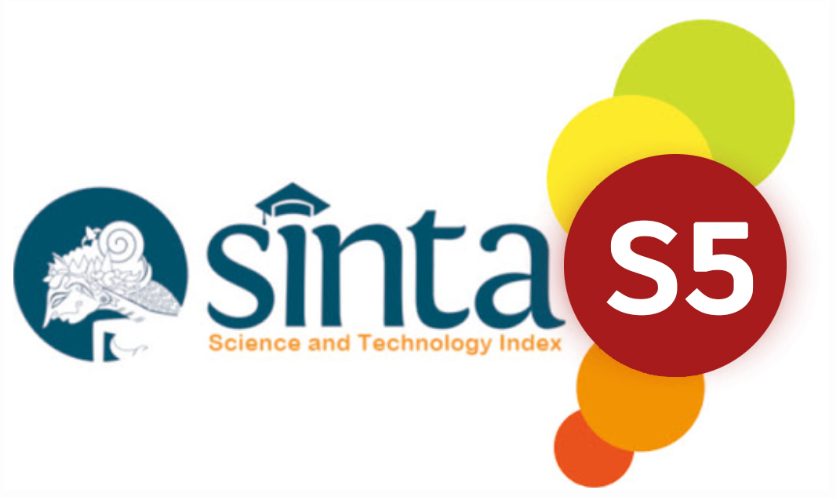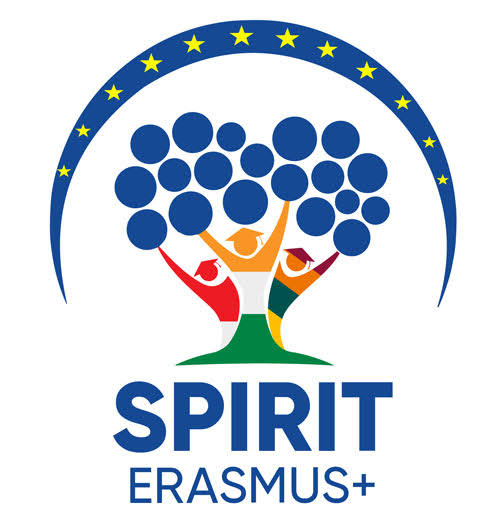Lipid Profile in Type 2 Diabetes Mellitus Patients With and Without Diabetic Retinopathy
DOI:
https://doi.org/10.32734/sumej.v7i3.15462Keywords:
diabetic retinopathy, insulin, lipid profile, total cholesterolAbstract
Background: Diabetes mellitus (DM) is a group of metabolic diseases characterized by hyperglycemia due to abnormalities in insulin secretion, insulin action, or both. Objective: To analyze differences in the proportion of lipid profile categories in type 2 DM patients with and without diabetic retinopathy. Methods: This was a hospital-based cross-sectional study with 45 samples. The independent variables assessed were the lipid profile, including LDL, HDL, triglycerides, and total cholesterol levels. The dependent variable assessed was the incidence of diabetic retinopathy. The analysis used were univariate and bivariate (Chi-square and Fisher exact). Results: The prevalence of diabetic retinopathy was 37.8%, consist of 17.8% of NPDR and 20% of PDR. There were significant differences in the proportion of LDL categories (p=0.007) and total cholesterol (p=0.038) in type 2 DM patients with and without diabetic retinopathy, and there were no significant differences in the proportion of HDL categories (p=0.719) and triglycerides (p=1) in type 2 DM patients with and without diabetic retinopathy. Conclusion: There were significant differences in the proportion of LDL categories and total cholesterol in type 2 DM patients with and without diabetic retinopathy.
Downloads
References
Perkumpulan Endokrinologi Indonesia. Pedoman Pengelolaan dan Pencegahan Diabetes Melitus Tipe 2 di Indonesia 2021. Jakarta: PB PERKENI; 2021. p. 6–7.
World Health Organization. Diabetes. Geneva: World Health Organization; 2022.
Browning DJ. Diabetic Retinopathy Evidence-Based Management. Springer; 2010.
Zheng Y, Ley SH, Hu FB. Global aetiology and epidemiology of type 2 diabetes mellitus and its complications. Nat Rev Endocrinol. 2018;14.
Wahyu T. The Epidemiology of Diabetic Retinopathy. Bandung: Community Ophthalmology. 2019;1(1):7–9.
Sasongko MB, Widyaputri F, Agni AN, Wardhana FS, Kotha S, Gupta P, et al. Prevalence of Diabetic Retinopathy and Blindness in Indonesian Adults with Type 2 Diabetes. Am J Ophthalmol. 2017;181:79–87.
Switania A, Halim A. Risk Factors of Diabetic Retinopathy and Vision Threatening Diabetic Retinopathy based on Diabetic Retinopathy Screening Program in Greater Bandung, West Java. 2018.
Harini I, Setyanto M. Hubungan antara Profil Lipid dengan Kejadian Retinopati Diabetika pada Pasien Diabetes Melitus Tipe 2 di Fasilitas Kesehatan Tingkat Pertama Klinik Tanjung. Jurnal Kesehatan Andalas. 2022.
Hammer SS, Busik JV. The Role of Dyslipidemia in Diabetic Retinopathy. Vision Res. 2017.
Agroiya P, Philip R, Saran S, Gutch M, Tyagi R, Gupta KK. Association of serum lipids with diabetic retinopathy in type 2 diabetes. Indian J Endocrinol Metab. 2013.
Mursi Z, Hendriati H, Isrona L. Hubungan kolesterol LDL dengan derajat retinopati diabetik di bagian mata RSUP Dr. M. Djamil Padang periode Januari–Desember 2015. Jurnal Kesehatan Andalas. 2018.
Rianita R, Bardoson S, Victor AA. Relationship between plasma lipid profile and the severity of diabetic retinopathy in type 2 diabetes patients. Med J Indones. 2008.
Khan MAB, Hashim MJ, King JK, Govender RD, Mustafa H, Al Kaabi J. Epidemiology of Type 2 diabetes – Global burden of disease and forecasted trends. J Epidemiol Glob Health. 2020;10(1):107–11.
Mordarska K, Godziejewska-Zawada M. Diabetes in the elderly. Prz Menopauzalny. 2017;16(2):38–43.
Kementerian Kesehatan RI. Laporan Nasional Riskesdas 2018. Jakarta: Badan Penelitian dan Pengembangan Kesehatan; 2018. p. 131.
Arisandi R, Himayani R, Maulana M. Hubungan Kadar HbA1c dengan Angka Kejadian Retinopati Diabetik pada Pasien Diabetes Melitus Tipe 2 yang Mengikuti Prolanis di Puskesmas Kedaton Kota Bandar Lampung. 2018.
Asiimwe D, Mauti GO, Kiconco R. Prevalence and Risk Factors Associated with Type 2 Diabetes in Elderly Patients Aged 45–80 Years at Kanungu District. J Diabetes Res. 2020.
Cardoza NJ, Radhakrishnan OK, Desai C, Mohankumar K, Mohan M. Association of serum lipid levels and social factors with diabetic retinopathy in patients with type 2 diabetes mellitus: Study from tertiary care center of Western Maharashtra. Indian J Clin Exp Ophthalmol. 2021;7(1):218–23.
Ozder A. Lipid profile abnormalities seen in T2DM patients in primary healthcare in Turkey: A cross-sectional study. Lipids Health Dis. 2014;13(1).
Wu L, Parhofer KG. Diabetic dyslipidemia. Metabolism. 2014;63(12):1469–79.
Asemu MT, Ahunie MA. The impact of diabetes on visual acuity in Ethiopia. PLoS One. 2021.
Purola PKM, Ojamo MUI, Gissler M, Uusitalo HMT. Changes in Visual Impairment due to Diabetic Retinopathy During 1980–2019 Based on Nationwide Register Data. Diabetes Care. 2022.
Matsuura E, Hughes GRV, Khamashta MA. Oxidation of LDL and its clinical implication. Autoimmun Rev. 2008;7:558–66.
Ganjifrockwala F, Joseph J, George G. Serum Oxidized LDL Levels in Type 2 Diabetic Patients with Retinopathy in Mthatha Region of the Eastern Cape Province of South Africa. Oxid Med Cell Longev. 2016.
Baynes JW, Thorpe SR. Role of oxidative stress in diabetic complications: a new perspective on an old paradigm. Diabetes. 1999.
Du M, Wu M, Fu D, Yang S, Chen J, Wilson K, et al. Effects of modified LDL and HDL on retinal pigment epithelial cells: a role in diabetic retinopathy? Diabetologia. 2013.
Jeng CJ, Hsieh YT, Yang CM, Yang CH, Lin CL, Wang IJ. Diabetic Retinopathy in Patients with Dyslipidemia: Development and Progression. Ophthalmol Retina. 2018;2(1):38–45.
Lieberman M, Peet A. Marks’ basic medical biochemistry: a clinical approach. 5th ed. Philadelphia, PA: Wolters Kluwer; 2017.
Chou Y, Ma J, Su X, Zhong Y. Emerging insights into the relationship between hyperlipidemia and the risk of diabetic retinopathy. Lipids Health Dis. 2020.
Ezhilvendhan K, Sathiyamoorthy A, Prakash B, Bhava B, Shenoy A. Association of dyslipidemia with diabetic retinopathy in type 2 diabetes mellitus patients: A hospital-based study. J Pharm Bioallied Sci. 2021.
Alattas K, Alsulami DW, Alem RH, Alotaibi FS, Alghamdi BA, Baeesa LS. Relation between lipid profile, blood pressure and retinopathy in diabetic patients in King Abdulaziz University hospital: a retrospective record review study. Int J Retina Vitreous. 2022;8(1).
Kinasih AS, Setyanto MR, Ernawati DA. Hubungan Kadar Trigliserida Dengan Kejadian Retinopati Diabetika Pada Pasien Diabetes Melitus Tipe 2: Studi Pada Fasilitas Kesehatan Tingkat Pertama (FKTP) Klinik Tanjung Purwokerto. Med Health J. 2023;2(2).
Raman R, Nittala MG, Gella L, Pal SS, Sharma T. Retinal Sensitivity over Hard Exudates in Diabetic Retinopathy. J Ophthalmic Vis Res. 2015;10(2):160.
Ovidiu M. Diabetic Macular Edema. Rom J Ophthalmol. 2015;59:133–6.
Hegde SS, Vekategowda HT. Association of Lipid Profile with Diabetic Retinopathy-A Comparative Study. Int J Health Sci Res. 2016;6(7):74.
Modjtahedi BS, Bose N, Papakostas TD, Morse L, Vavvas DG, Kishan AU. Lipids and diabetic retinopathy. Semin Ophthalmol. 2016;31:10–8.
Downloads
Published
How to Cite
Issue
Section
License
Copyright (c) 2024 Sumatera Medical Journal

This work is licensed under a Creative Commons Attribution-ShareAlike 4.0 International License.
The Authors submitting a manuscript do so on the understanding that if accepted for publication, copyright of the article shall be assigned to Sumatera Medical Journal (SUMEJ) and Faculty of Medicine as well as TALENTA Publisher Universitas Sumatera Utara as publisher of the journal.
Copyright encompasses exclusive rights to reproduce and deliver the article in all form and media. The reproduction of any part of this journal, its storage in databases and its transmission by any form or media, will be allowed only with a written permission from Sumatera Medical Journal (SUMEJ).
The Copyright Transfer Form can be downloaded here.
The copyright form should be signed originally and sent to the Editorial Office in the form of original mail or scanned document.











